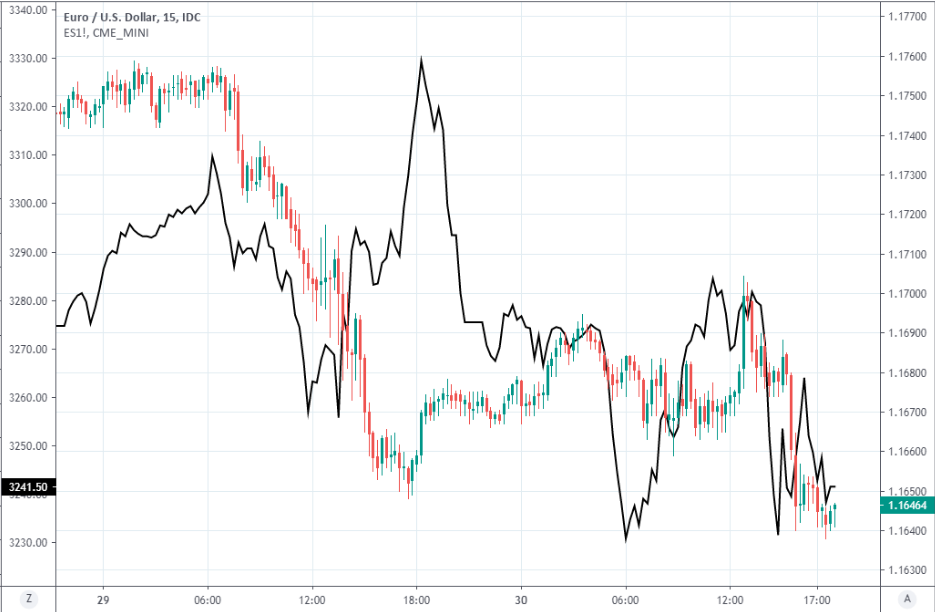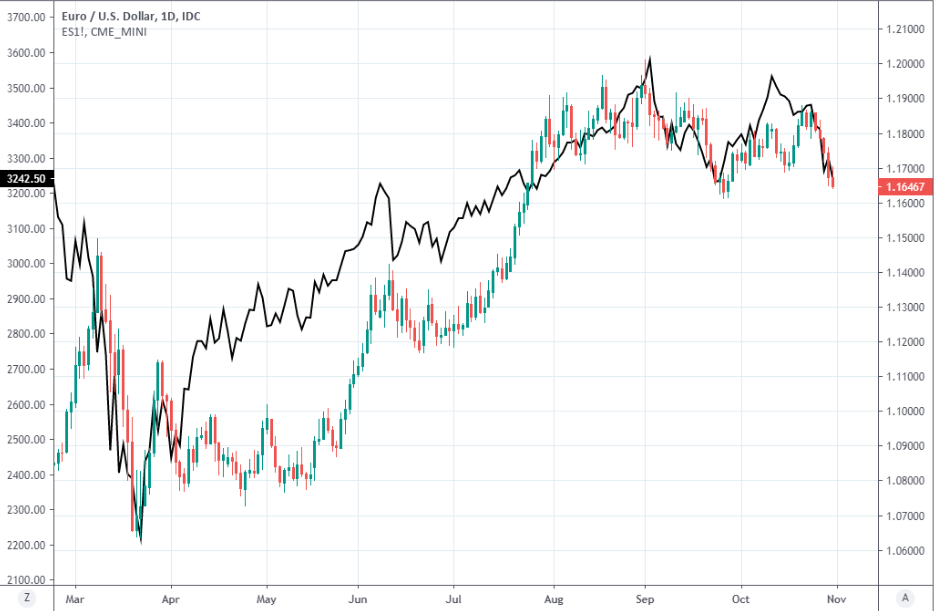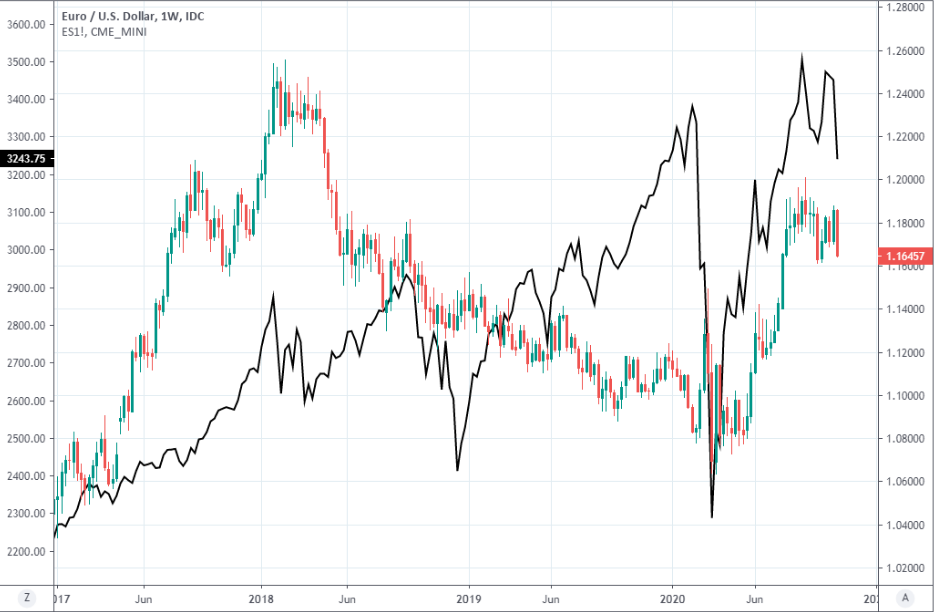Euro-Dollar Falls to September Low as Virus, ECB and U.S. Election Drive Market Rout
- Written by: James Skinner
-

Image © Adobe Images
- EUR/USD spot rate at time of writing: 1.1645
- Bank transfer rate (indicative guide): 1.1237-1.1319
- FX specialist providers (indicative guide): 1.1470-1.1540
- More information on FX specialist rates here
The Euro slumped to the bottom of the major currency league table on Friday, led by a retreating Euro-Dollar rate which fell alongside the S&P 500 and other stock indices in late noon trading as concerns about the coronavirus, European Central Bank (ECB) policy and U.S. election saw risk appetite evapourate.
Europe's single currency was back late September lows against the Dollar on Friday after suffering a fifth consecutive decline and its longest run of unbroken losses for more than two months, with new 'lockdowns,' threats of more ECB easing and unease over risks associated with next week's U.S. election weighed on risk assets all week long.
High volumes of adverse newsflow make disentangling the effect of one driver from the other an even more subjective exercise than usual although, with the oil-linked Norwegian Krone and risk sensitive Swedish Krona aside, the Euro was comfortably the worst performing major currency of the week.
"In our view the recent newsflow has heightened the risk that optimism that lifted the EUR through the spring and summer is now facing a reality check. Simultaneously, the USD has been receiving a bid from safe haven demand," says Jane Foley, a senior FX strategist at Rabobank. "We see scope for a move towards the EUR/USD1.16 level on a 1 to 3 month view. Dependent on the path of the pandemic and on the results of the US election, we see scope for a drop to the 1.14 area in the coming months."
Eurostat said Friday that Europe's economy rebounded strongly out of its coronavirus-induced trough last quarter, but the recovery has since been followed by another 'lockdown' of the Eurozone's major economies including Germany and France, throwing the outlook into doubt.
Further doubt was cast over the outlook by ongoing delays in agreeing the final details of the much-vaunted coronavirus recovery fund that was celebrated this summer at a time when national leaders and their representatives still had neogotiating over a number of key issues left to do.
As a result, Friday's the data was overlooked by the market and Euro-to-Dollar rate, which appeared to have been more concerned with the deteriorating economic outlook, prospect of a further expansion of the ECB's balance sheet and risks surrounding the U.S. election.
Above: Euro-to-Dollar rate shown at 15-minute intervals alongside S&P 500 index futures.
"Independent of the EUR’s souring tone, the USD has been bid higher during late October with safe haven demand likely being a significant contributing factor," Foley says. "The Fed’s liquidity measures should insure that there is no repeat of the panicked demand for USDs that was evident in March. That said, it is unlikely that many investors are willing to sit through the recent slew of worrisome news headline with short USD positions."
This is after ECB President Christine Lagarde said on Thursday that mounting risks to the outlook for the economy call for a "recalibration of all instruments" and the implementation of a recalibrated package of policy supports.
That likely means the bank will offer more cheap money directly to commercial lenders, which it would describe as an increase in its targeted-long-term-refinancing-operations, and an expansion of the pandemic-related quantitative easing programme known as the Pandemic Emergency Purchase Programme.
Under the latter the ECB would buy more continental government bonds using newly created Euros, which would enlargen its balance sheet while lessening the relative appeal to investors of the Euro compared with the Dollar.
The Dollar has suffered greatly this year in part because the Federal Reserve has expanded its own balance sheet to such an extent.
"The key variable to watch is neither the ECB policy response nor the scale of the lockdowns," says George Saravelos at Deutsche Bank. "It is a stabilization in virus numbers over the next couple of weeks. Provided that happens, we continue to believe the US election combined with a potential vaccine announcement is more important as a market driver for the rest of the year."
Above: Euro-to-Dollar rate shown at daily intervals alongside S&P 500 index futures.
Saravelos and the Deutsche team say a combination of Fed policy and increased U.S. government spending are likely to sink the Dollar further over the coming year, as they appeared to this summer, and that this should lift not only the Euro but also commodity and emerging market currencies too.
Such a double-deficit driving fiscal policy bent, where the budget deficit expands alongside the balance of payments deficit, will weigh heavily on the Dollar but that Federal Reserve money creation aimed at hoovering up the increased debt supply will exacerbate declines.
"The key thing for Europe is that the virus numbers are brought back into control and that we don't see a repeat of the Great March Shutdown. In the meantime, the US election next week is more important," Saravelos says.
That Dollar negative policy mix becomes more potent if pollsters, financial markets and bookmakers are right to anticipate a victory by the opposition Democratic Party. A White House led by opposition candidate Joe Biden would be expected to spend even more than a second iteration of the Trump administration while adding an onerous regulatory and tax agenda on top.
But containment of the coronavirus in Europe, without governments resorting to the more draconian forms of 'lockdown' seen in the first half of the year, is key to the Euro's ability to capitalise on that for the Deutsche Bank team, who forecast a Euro recovery by year-end.
"Irrespective of the impact on the USD from either the covid-19 crisis or the US election we would argue that the rise in EUR long positions through the spring and summer months increasingly appears top heavy," says Rabobank's Foley, who sees the Euro ending 2020 near current levels before falling to 1.14 early in 2021. "CFTC speculators’ data suggest that there has already been some pairing back of these positions from their summer peak and this week’s price action suggests this has continued in recent sessions. We would argue that this trend has further to go ahead of the next ECB policy meeting in December."
Above: Euro-to-Dollar rate shown at weekly intervals alongside S&P 500 index futures.







